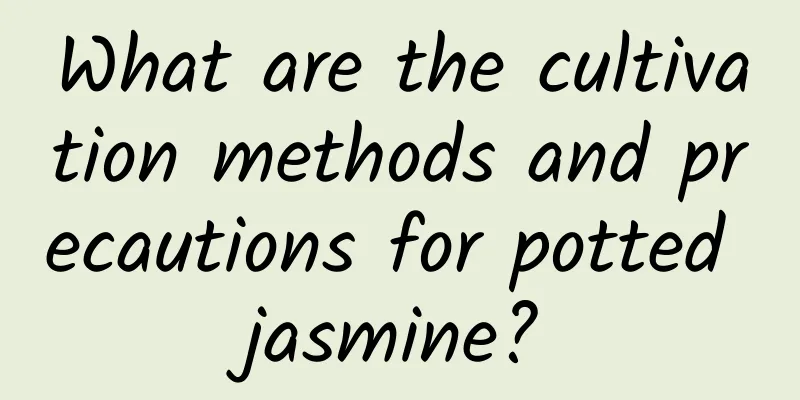What are the cultivation methods and precautions for potted jasmine?

Jasmine growth habitsJasmine likes a warm, humid environment with plenty of sunshine. Its leaves are emerald green, its flowers are white, and it has a strong fragrance. Most varieties bloom from June to October. It is highly ornamental and suitable for growing at home. The methods of propagating jasmine include cuttings, layering, and division. How to grow potted jasminePotted jasmine prefers a warm, humid, well-ventilated semi-shady environment. It is suitable for planting in slightly acidic sandy loam rich in humus. It is not cold-resistant. If the temperature is lower than 3 degrees in winter, the branches and leaves are prone to frost damage. If it lasts for a long time, it will die. It is not tolerant to waterlogging. Watering methodJasmine should be watered according to the principle of not watering unless the soil is dry, and making sure to water thoroughly when watering. In spring and autumn, it is generally watered once every 2 to 3 days, and can be sprayed once a day. In summer, it is sprayed twice a day. In winter, the amount of watering should be reduced in the greenhouse, otherwise the roots will easily rot. Fertilization methodJasmine likes fertilizer. After moving it out of the room in spring, you can water it with some dilute alum fertilizer water. As the weather temperature rises, the plant's growth potential increases and the demand for fertilizer increases. Fertilizer can be applied in time. Phosphorus and potassium fertilizers can be applied before flowering. Stop applying fertilizer during the peak flowering period and stop fertilizing after bringing it indoors in winter. Pruning methodsJasmine can be pruned in spring, mainly by cutting off dense branches, dry branches, diseased branches, crossed branches, etc., and cutting the overgrown branches short to promote the growth of new branches, which is beneficial to flowering. In addition, after the flower buds bloom in spring, some of them can be thinned out. After the flowers fade, the remaining flowers should be removed in time to promote the next flowering. Precautions for potted jasmine cultivationPotted jasmine likes high temperatures, but it cannot be exposed to direct sunlight in the high summer temperatures. In addition, it also likes a humid environment. Generally, when the soil moisture content is around 60%, it is beneficial to the growth of the plant roots. However, jasmine avoids water accumulation. If the soil is too moist, it will cause root rot. |
<<: What are the cultivation methods and precautions of Panax notoginseng?
>>: Is an onion a fruit or a vegetable?
Recommend
The correct way to water Clivia with beer. How to mix beer and water for watering Clivia?
How to water Clivia with beer Watering Clivia wit...
How to Root Gardenia
1. How to promote rooting in soil culture 1. Proc...
How to cultivate bamboo
1. Maintenance methods 1. Temperature: It likes m...
Cultivation methods and precautions of white rib amaryllis
White rib amaryllis is very easy to grow. It has ...
Cultivation methods and precautions of chrysanthemum
How to cultivate chrysanthemum Pot soil selection...
How to raise a smooth sailing
1. Breeding environment 1. Flower pot: You can us...
How to grow crabapple
1. Water Begonia is suitable for growing in a rel...
These flowers grow fastest in summer. If you miss this period, it will be too late to regret!
Cactus 1. Get sunlight In summer, cacti can be ex...
When is the apricot blossom blooming?
1. Which season? Apricot blossoms bloom in spring...
How many days does it take for onions to germinate after sowing?
Scallions can be planted directly. It is best to ...
How to repot the ash tree
1. Remove the plant The ash wood needs to be repo...
How to cultivate Euphorbia pulex
1. Soil: Euphorbia lactea has strong adaptability...
Planting methods and precautions for wintersweet
1. Prepare the soil Before planting wintersweet, ...
The Difference Between Green Olives and Black Olives
1. Differences in tree trunks The trunk height of...
Varieties of aster
Aster variety: Asteroid series The plant is about...









